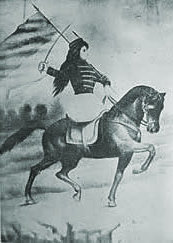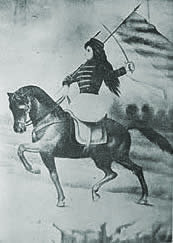
|
Women and Independence in Latin America An exploration of women's involvement in the Latin American Wars of Independence |

|

|
Women and Independence in Latin America An exploration of women's involvement in the Latin American Wars of Independence |

|
Gender:Female
Ethnic origen: Unknown
Events:
| 1780 | - | Michoacán | - | Not applicable | - | She was born in Erongarícuaro, Michoacán. |
| 1817 | - | Michoacán | - | Patriot | - | She was executed by the royalists in February 1817. |
Connections:
Women executed independence cause (Mexico)Biography:
From Michoacán, Mexico, she was executed in 1817 for her efforts on behalf of the insurgents. She saw fighting for Mexico as the fulfilment of her duty. (Salas, 27-28.)
She and Gertrudis Bocanegra participated in the independence movement. Both were executed. (Knaster, 477.)
She was born in Erongarícuaro, Michoacán and married Esteban García Rojas, "El Jaranero". This was a royalist town, but she supported the independence cause. She sent messages to the patriots and gave financial support to them. A package containing letters from the patriot Tomás Pacheco, sent by Martínez was intercepted by General Pedro Celestio Negrete, leader of the royalist forces in Zaragoza. On learning this, Martínez fled, but was followed and taken prisoner. She was sentenced to death, but paid Negrete 2,000 peso and was freed after she promised never again to serve the independence cause. She nonetheless continued to serve the patriots and was imprisoned again two years later, again by Negrete. She was again sentenced to death, but again avoided this by paying Negrete another 2,000 pesos and giving him another promise not to work for the independence cause again. She again continued to work for the patriots and was again arrested, this time by Chivili. She was again sentenced to death and again avoided this by paying Chivili the lesser sum of 1,000 pesos. On her release she resumed her pro-independence activities and was again arrested, this time by Negrete. This time he demanded 4,000 pesos for her release; this was beyond her means and she was shot. A few hours before her death, Martínez asked, 'Why are you so persistent in your persecution of me? I have the right to do what I can for my country, because I'm a Mexican woman. I don't believe I've committed any crime, I've just fulfilled my duty.' Her words were to no avail and she was executed in 1817 in Erongarícuaro, Michoacán. (Muñoz y Pérez, 1, 3)
She had a shop in Erongarícuaro. She sent details of the movements of the royalist troops to the patriots. She was discovered, imprisoned, and sentenced to death. She was executed in February 1817. (Miquel i Vergés, 365)
She was married to Esteban García Rojas, "el Jarenero", who had a shop in the royalist town of Erongarícuaro. She served royalist troops in her shop and passed on news she heard to the patriots. She was discovered and fled, but was captured and paid 2,000 pesos for her release. This happened another 3 times before she was executed in 1817. (González Obregón, 161-162)
References:
González Obregón, Luis (c1952) Los procesos militar e inquisitorial del Padre Hidalgo y de otros caudillos insurgentes
Knaster, Meri (1977) Women in Spanish America: An Annotated Bibliography from Pre-Conquest to Contemporary Times
Miquel i Vergés, José María (1969) Diccionario de Insurgentes
Muñoz y Pérez, Daniel (1961) Doña Gertrudis Bocanegra y Doña María Luisa Martínez
Salas, Elizabeth (1990) Soldaderas in the Mexican Military: Myth and History